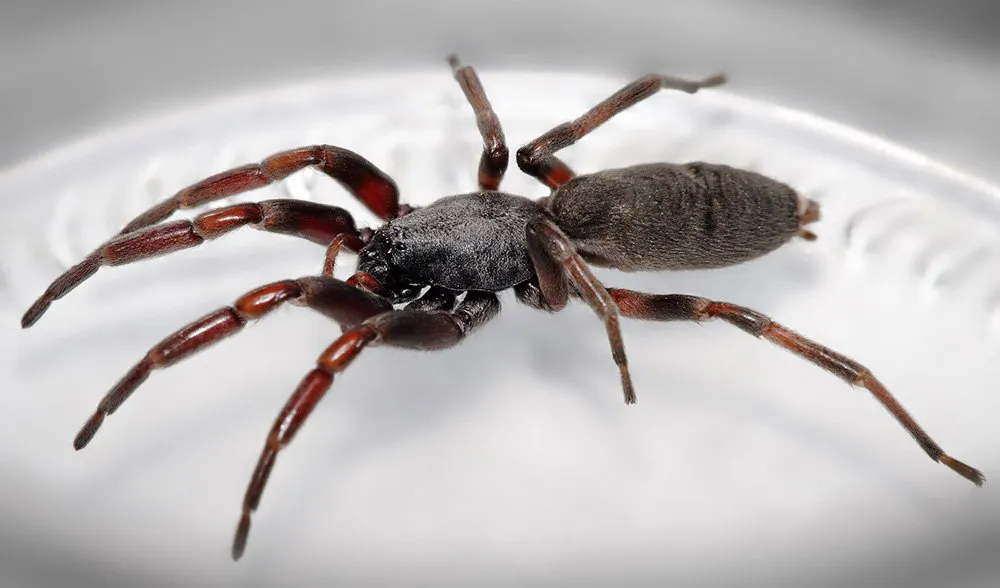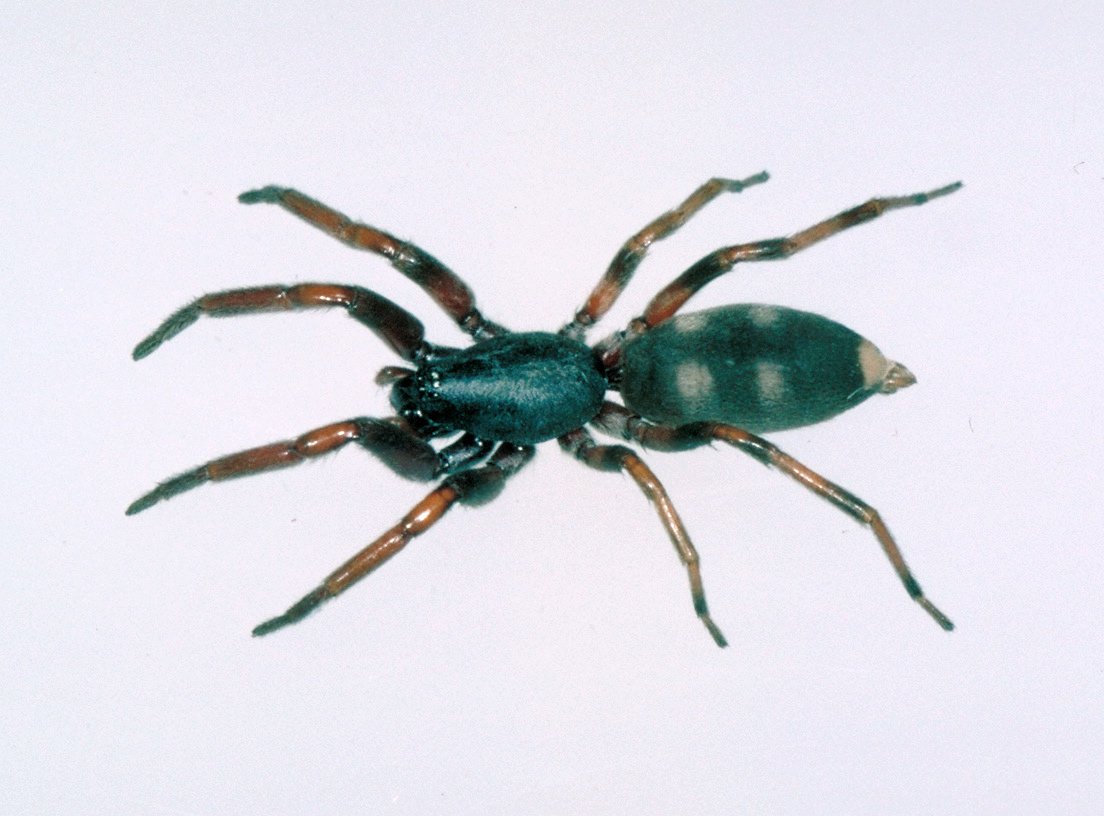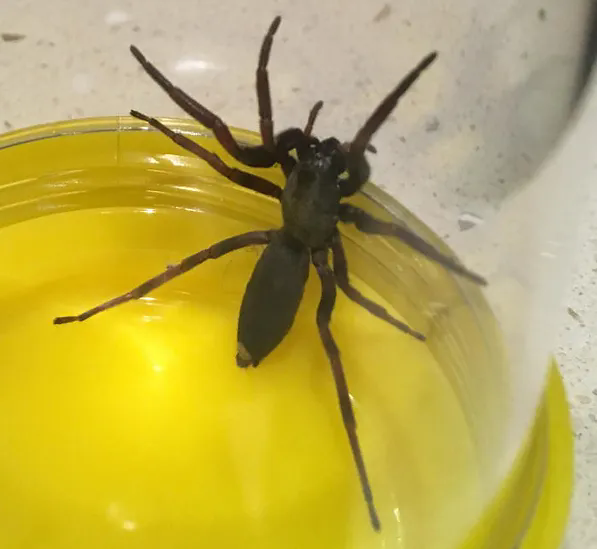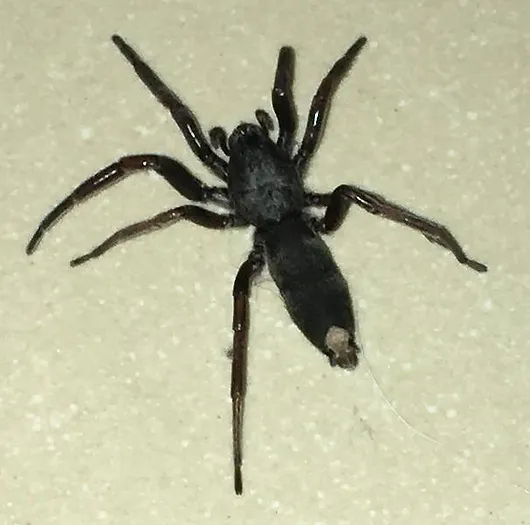
The White Tailed Spider (Lampona cylindrata) is about the size of a 50c piece when fully grown, with a leg diameter about the size of a pin.
It has a grey cigar-shaped abdomen with a white spot on the end and sometimes the legs are banded with light traverse marks on the abdomen. These markings are more predominant on the juvenile White Tailed spider. It is typically found in cool, dark areas – under bark, in gardens, litter, walls and beds.
It is active at night time and often enters buildings where it can be seen walking across floors and up walls. It is commonly found in the bedroom and during daylight hours, the spider seeks a dark place to hide. Indoors, this may be in clothing that has been left lying about and bites may occur when this clothing is put on.
It is most prevalent in Spring – Autumn and there are many species in Australia and New Zealand. The White Tailed Spider does not usually build a web, preferring to rove around. It prefers to nip and run when cornered but can bite repeatedly. Bites by this spider are relatively frequent due to its wandering habit.
The bite symptoms vary from no reaction to local pain, swelling, redness and small local ulcers that usually clear up in a few days although more serious reactions have been claimed.
White Tailed Spider venom comes up non-necrotic. Although it has been suggested as a culprit in rare cases of large scale necrotic lesions, there is little supporting evidence.

Introduction
White-tailed Spider bites have been controversially implicated in causing severe skin ulceration in humans.
Identification
White-tailed Spiders have a dark reddish to grey, cigar-shaped body and dark orange-brown banded legs. The grey dorsal abdomen bears two pairs of faint white spots (less distinct in adults) with a white spot at the tip; the male has a hard, narrow plate or scute on the front of the abdomen. The two common species in southern Australia, Lampona cylindrata and L. murina, are similar in appearance and have overlapping distributions in the south-east. Their bites have been controversially implicated in causing severe skin ulceration in humans.
Habitat
White-tailed Spiders are vagrant hunters that live beneath bark and rocks, in leaf litter, logs and detritus in bush, gardens and houses.
Distribution
Lampona cylindrata is found across southern Australia (south east Queensland, New South Wales, Victoria, South Australia, Tasmania, Western Australia). Lampona murinais present in eastern Australia from north-east Queensland to Victoria (Queensland, New South Wales, Victoria,).

Feeding and diet
They are most active at night when they wander about hunting for other spiders, their preferred food. They have been recorded eating curtain-web spiders (Dipluridae), daddy-long-legs spiders (Pholcidae), Redback Spiders (Theridiidae) and black house spiders (Desidae) During summer and autumn White-tailed Spiders are often seen in and around houses where they find both sheltered nooks and crannies and plenty of their favoured black house spider prey.
Life history cycle
Tufts of specialised scopulate hairs on the ends of their legs allow them to walk easily on smooth or sloping surfaces. They make temporary silk retreats and spin disc-shaped egg sacs, each containing up to 90 eggs.
Management
White-tailed Spiders around your house can be controlled by catching and removing any that you see and by clearing away the webs of the house spiders upon which they feed.
Danger to humans
White-tailed Spider bites can cause initial burning pain followed by swelling and itchiness at the bitten area. Occasionally, there are unconfirmed reports of weals, blistering or local ulceration – conditions known medically as necrotising arachnidism.
A debate continues about the involvement of White-tailed Spider bite in cases of severe ulcerative skin lesions seen in patients diagnosed as probable spider bite victims. Typically, in such cases no direct evidence of spider bite is available. Sensational media reporting of supposed cases of severe “necrotising arachnidism” has given the White-tailed Spider a bad reputation. However, a recent study has monitored the medical outcomes of over 100 verified White-tailed Spider bites and found not a single case of ulceration (confirming the results of an earlier study). The available evidence suggests that skin ulceration is not a common outcome of White-tailed Spider bite.

What is a white-tailed spider?
There are two common species of white-tailed spiders in Australia: Lampona cylindrata and Lampona murina. They are both part of the Lampona genus, native to Australia and New Guinea.
White-tail spiders are vagrant hunters that usually roam at night. Instead of spinning webs and eating insects, they prefer to feast on other spiders, such as curtain-web spiders, daddy-long-legs, redback spiders, and black house spiders.
What does a white-tailed spider look like?
White-tailed spiders have a dark reddish grey colour with a cylindrical, cigar-shaped body. Their defining feature is a white spot at their tip. The male spider’s abdomen is 12mm, and the female spider’s abdomen is 18mm – roughly the size of your fingernail.
Where do white-tailed spiders live?
The Lampona genus is abundant, with some 60 species distributed throughout Australia. According to the 2003 study, L. cylindrata can be found across southern Australia, in southeast Queensland, New South Wales, Victoria, South Australia, Tasmania and southern Western Australia. L. murina is found in Queensland, New South Wales and Victoria. Both species have also been found in New Zealand.
White-tailed spiders are adaptable to both bush and urban environments. The spiders like to hide beneath bark, rocks, plant litter, in gardens and within tight spaces inside of homes.
You are most likely to find a white-tailed spider indoors, at night, and during the warmer months. But have no fear – white-tailed spiders live in homes to prey on black house spiders, not human beings.
What happens when you get bitten by a white-tailed spider?
Most spiders, such as the white-tailed spider, don’t want to bite you. “They will only bite if provoked,” says Geoff.
In the 2003 study, 95 per cent of the bites investigated occurred indoors, and 75 per cent between 4pm and 8am.
The preferred hiding spots of white-tailed spiders are between pieces of fabric. Two-thirds of bite victims found the spiders nestled in bedclothes, towels, and clothing. (So it’s a good idea to shake out your sheets and towels if you’re afraid of spiders!)
If you do get bitten by a white-tailed spider, the symptoms are similar to those of a bee sting: an immediate burning sensation in the local area, followed by mild swelling and an itchy red mark.
Geoff and co-author Michael Gray – a spider expert at the Australian Museum – concluded in their 2003 study that the symptoms of a white-tailed spider bite follows three patterns: pain only, pain and a red mark lasting less than 24 hours, or pain and an irritating red lesion lasting from 5-12 days.
Eighty-three per cent of the spider bites resulted in a red mark. Out of the 130 cases in the study, none resulted in necrotic ulcers.
Pain and discomfort occurred in all cases, but only 27 per cent of cases reported “severe” pain, which was classified in the study as “pain greater than a bee sting or equivalent”.
Another study in The Medical Journal of Australia in 1989 tested and identified eight white-tailed spider bites, and the results concluded that the bite caused only local swelling, mild pain, and itchiness and either no systemic symptoms, or anxiety.
What should you do if you get bitten by a white-tailed spider?
Rule number one: it may be painful, but do not panic. Of the 130 patients in the 2003 study, zero needed to be admitted to the hospital after the bite.
Always clean the site of your bite. The most common treatment for white-tailed spider bites is icepacks to reduce the swelling. Other than that, there are no other necessary first-aid treatments, says Geoff, “except to make sure your tetanus shot is up to date like any spider bite or wound”.
